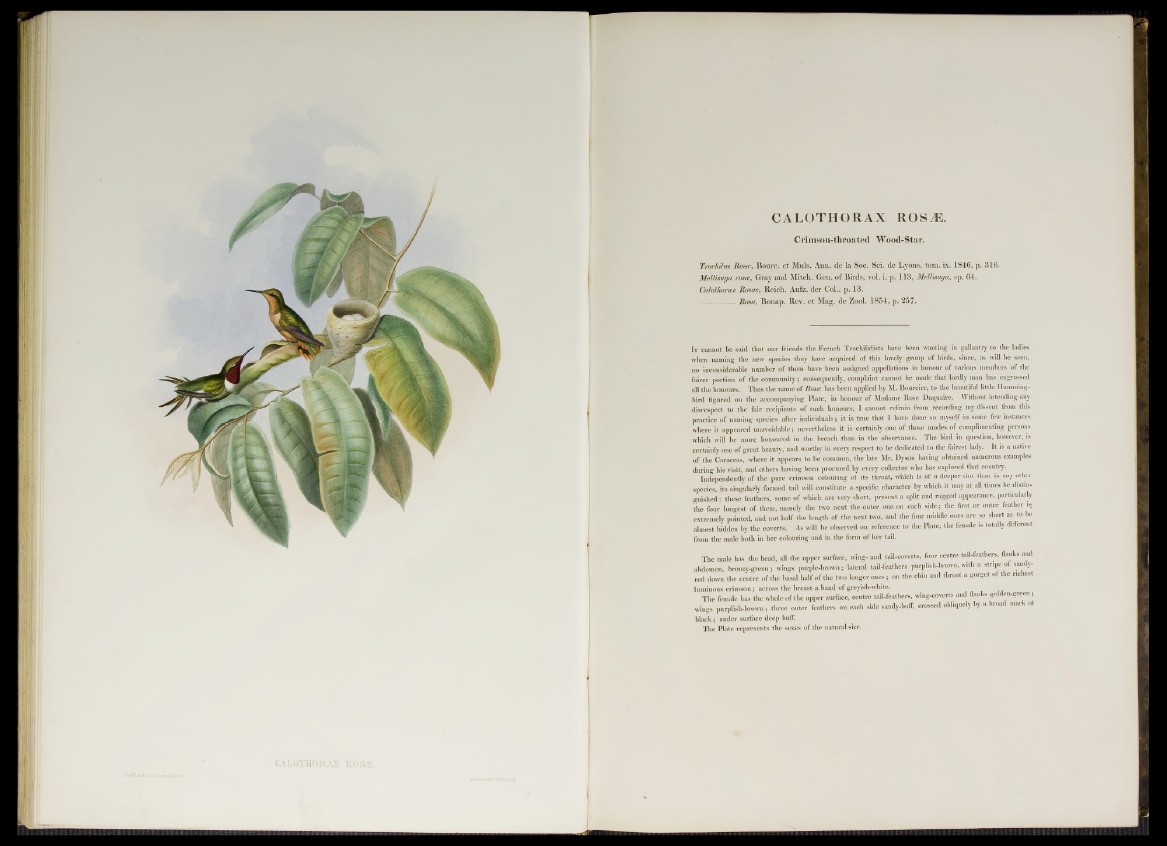
CALOTHORAX ROSJE.
Crimson-throated Wood-Star.
Trochilm Roses, Bourc. et Muls. Ann. de la Soc. Sci. de Lyons, tom. ix. 1846, p. 316.
Mellisuga roses, Gray and Mitch. Gen. of Birds, vol. i. p. 113, Mellimga, sp. 64.
Calothorax Rosae, Reich. Aufz. der Col., p. 13.
Rosa, Bonap. Rev. et Mag. de Zool. 1854, p. 257.
I t cannot be said that our friends the French Trocliilidists have been wanting in gallantry to the ladies
when naming the new species they have acquired of this lovely group of birds, since, as will be seen,
no inconsiderable number of them have been assigned appellations in honour of various members of the
fairer portion of the community; consequently, complaint cannot he made that lordly man has engrossed
all the honours. Thus the name of Roses has been applied by M. Bourcier, to the beautiful little Hummingbird
figured on the accompanying Plate, in honour of Madame Rose Duquaire. Without intending any
disrespect to the fair recipients of such honours, I cannot refrain from recording my dissent from this
practice of naming species, after individuals; it is true that I have done so myself in some few instances
where it appeared unavoidable; nevertheless it is certainly one of those modes of complimenting persons
which will be more honoured in the breach than in the observance. The bird in question, however, is
certainly one of great beauty, and worthy in every respect to be dedicated to the fairest lady. It is a native
of the Caraccas, where it appears to be common, the late Mr. Dyson having obtained numerous examples
during his visit, and others having been procured by every collector who has explored that country.
Independently of the pure crimson colouring of its throat, which is of a deeper tint than in any other
species, its singularly formed tail will constitute a specific character by which it may at all times be distinguished:
these feathers, some of which are very short, present a split and ragged appearance, particularly
the four longest of them, namely the two next the outer one on each side; the first or outer feather is
extremely pointed, and not half the length of the next two, and the four middle ones are so short as to be
almost hidden by the coverts. As will be observed on reference to the Plate, the female is totally different
from the male both in her colouring and in the form of her tail.
The male has the head, all the upper surface, wing- and tail-coverts, four centre tail-feathers, flanks and
abdomen, bronzy-green; wings purple-brown; lateral tail-feathers p u r p l i s h - b r o w n ,with a stripe of sandy-
red down the centre of the basal half of the two longer ones; on the chin and throat a gorget o t e ric es
luminous crimson; across the breast a band of greyish-white.
The female has the whole of the upper surface, centre tail-feathers, wing-coverts and flanks golden-green;
wings purplish-brown; three outer feathers on each side sandy-buff, crossed obliquely by a broad mark o
black; under surface deep buff.
The Plate represents the sexes of the natural size.